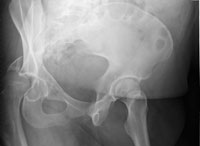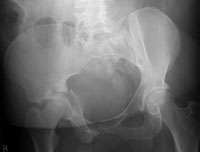Fewer wound complications seen with incisional negative pressure wound therapy
Click Here to Manage Email Alerts
Incisional negative pressure wound therapy significantly reduced the rate of postoperative wound complications in patients operatively treated for acetabular fractures, according to studies recently published by investigators from University of North Texas Health Science Center in Fort Worth, Texas.
“This technique is one that offers a surgeon a potential advantage of closing off a postoperative surgical incision from the environment and can potentially help the wound to heal quicker, thus avoiding the complications that could come from dependent wounds in obese patients,” Robert N. Reddix, Jr., MD, told Orthopedics Today. “In the standard patient, it offers the same potential advantages. … We found that the application of the incisional vacuum-assisted closure [IVAC] device significantly decreased postoperative wound complications.”
A retrospective study
In a retrospective study published in the Journal of Surgical Orthopedic Advances, Reddix and colleagues reviewed 301 patients who underwent acetabular fracture surgery performed by a single surgeon between 1996 and 2005. They compared the results of a control group that included 66 patients between 16 years and 80 years old who were treated in the 5 years before the use of IVAC to a group of 235 patients aged 11 years to 75 years who received care using IVAC.
|
|
|
|
Judet plain radiographs of an acetabular fracture patient are shown. Images: Reddix RN |
|
After closing the wound, an Adaptic dressing (Johnson & Johnson Wound Management) was placed on the wounds in patients in the experimental group and covered with a sponge. The surgeon then applied IVAC to the infected area.
The investigators found three cases (1.27%) of deep infection and one wound dehiscence (0.426%) in the IVAC group — a significant decrease from the four deep infections (6.15%) and two wound dehiscences (3.03%) found in the control group.
An obese cohort
Reddix also noted that the negative pressure wound therapy shows promise for use with obese patients. In a study published in the American Journal of Orthopedics, Reddix and colleagues studied 19 patients with a body mass index (BMI) >40 who underwent surgery for an acetabular fracture and were treated with IVAC. The patients were between 20 years and 72 years old with an average BMI of 48.7.
After an average postoperative follow-up of 21 months, the researchers found that none of these patients had a postoperative wound infection.
|
|
“The wounds are hard to take care [of] in those folks, especially when they are in the ICU, and they are unresponsive and nurses have to turn somebody that is rather large. That was the biggest place where we actually saw an immediate impact in this institution.” Reddix said.
The next step is to develop a prospective, randomized study which would serve as a “gold standard in which you could then have some hard, fast data for surgeons to hang their hats on in terms of medical decision making,” Reddix said. – by Jeff Craven
References:
- Reddix RN Jr., Leng XI, Woodall J, et al. The effect of incisional negative pressure therapy on wound complications after acetabular fracture surgery. J Orthop Adv. 2010; 19:91-97.
- Reddix RN Jr., Tyler HK, Kulp B, Webb LX. Incisional vacuum-assisted wound closure in morbidly obese patients undergoing acetabular fracture surgery. Am J Orthop. 2009; 38:446-449.

- Robert N. Reddix Jr., MD, can be reached at the Department of Orthopedic Trauma, John Peter Smith Hospital, 1500 S. Main Street, Fort Worth, Texas; 817-927-1370; email: rreddix@jpshealth.org.
- Disclosure: Reddix has no relevant financial discloures. Webb is a consultant for KCI.



